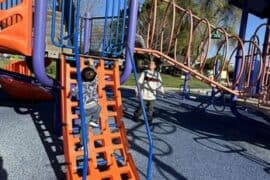Parents’ Guide to Understanding “The Stranger”
Hello, fabulous parents! We’re diving straight into a topic that’s critical for all parents to grasp: the concept of “the stranger” and how to teach your children about it. No matter how daunting it may sound, we’re here to make it simple, friendly, and straightforward. Let’s break it down together, shall we?
Tackling ‘The Stranger’ Topic With Your Child
Discussing strangers with children can seem scary, but believe it or not, it doesn’t have to be. Turn it into a positive learning experience! Ensuring our children’s safety is essential, and sometimes that means having those difficult conversations. We will guide you through the process and make it as helpful as possible.
Understanding ‘The Stranger’ Concept
The term “stranger” refers to someone completely unknown or unfamiliar to us. While it’s certainly not the case that every stranger is a threat, teaching our children about stranger safety is an integral part of their growth and development. Let’s dive into how you can effectively approach this subject.
Initiating the Conversation
How do we start this conversation? It doesn’t have to be daunting, promise! Begin by discussing the difference between ‘familiar’ and ‘unfamiliar’ people. Make sure to use examples that are simple and relatable to their everyday life. For example, you could explain that the lady who sells your favorite ice cream in the park is a familiar person, while someone you’ve never seen before at the playground is a stranger.
Teaching Children About ‘Stranger Danger’
Now, on to the next step – how to tackle the infamous ‘Stranger Danger’ discussion. Just mentioning the term can seem a tad scary, but don’t worry – we’re here to ease your fears and give you some handy strategies to make the topic approachable and manageable.
‘Stranger Danger’: What It Really Means
‘Stranger Danger’ has evolved in its meaning over the years. It’s not about instilling fear or mistrust in your child – quite the opposite! It’s about empowering your child with knowledge and understanding. They need to know how to identify potential dangers, recognize safe and unsafe situations, and what to do if they ever feel uncomfortable.
Setting Boundaries and Safety Rules
The core of teaching ‘Stranger Danger’ is about setting boundaries and safety rules. Your role as a parent is to ensure that your child understands these boundaries and respects them, but also knows they can ask for help if something isn’t right. This includes teaching them never to respond or go with a stranger, and to always stay close to trusted adults.
Every Conversation Matters
Remember, every conversation you have with your child matters. It’s okay if they don’t understand everything right away. Reinforcing these lessons over time will eventually lead to understanding and, more importantly, safer practices. Keep the conversation positive, clear, and consistent. We are in this journey together, and with love and knowledge, we can make the world a safer place for our little ones.
Stay tuned for the next piece in our parents’ guide series. Knowing is half the battle, right? Having these informed conversations with your children is the first step in protecting them from potential dangers – we’re just happy to be a part of that journey.

Useful Guide for Parents: Understanding ‘The Stranger’
Greetings amazing parents! Today, we will be discussing a quintessential topic, the concept of ‘the stranger’. It might sound a bit menacing, but don’t be alarmed! We are here to turn this crucial topic into an easy and effective learning process for you and your child. Let’s get on with it, shall we?
Navigating the ‘Stranger’ Concept with Your Child
The idea of strangers can appear frightening at first, but it’s an important conversation to have for your children’s safety. Moreover, this discussion can positively shape their perspective and understanding of the world. So, let’s explore how to approach this subject the right way.
Grasping the ‘Stranger’ Concept
A ‘stranger’ simply refers to a person your child doesn’t know or hasn’t interacted with. Teaching children about stranger safety does not mean cultivating fear but progress towards their informed growth and development. The key here is to be open, basic and relatable when explaining this concept.
Initiating the Conversation
How do we kickstart this conversation? Keep it simple! Drawing a clear line between unfamiliar and familiar individuals is a good starting point. You can use everyday analogies to illustrate your point. For instance, the grocery store cashier they often see is a familiar person, while someone at a new park is a stranger.
Empowering Children Through ‘Stranger Danger’ Info
Moving on to ‘Stranger Danger’, a phrase that sounds ominous but can be dealt with lightly and effectively through proper strategies. The term emphasizes awareness rather than paranoia. Let’s check out some useful ways to teach kids about this.
Understanding ‘Stranger Danger’
‘Stranger Danger’ doesn’t signify mistrust or fear, it focuses on awareness and prevention. Boosting your kids’ knowledge and understanding, making them cognizant about potential dangers, recognizing safe and unsafe circumstances, and know-how if they ever feel uneasy is what this all about.
Establishing Boundaries and Safety Protocols
‘Stranger Danger’ fundamentally revolves around setting boundaries and safety rules. Your goal should be to help your child understand and respect these boundaries, while also making it clear that they can seek help when something seems off. Always promote the idea that they should never interact or accompany a stranger, and always stay in the vicinity of a trusted adult.
Importance of Regular Conversations
Each conversation you have with your child carries immense significance. Even if they don’t grasp everything immediately, recurring discussions will eventually lead to comprehension and adherence, ultimately leading to a safer environment. The trick lies in keeping the conversation light, clear, and constant. As we navigate this journey together, let’s promise to arm our kids with love, knowledge, and safety instructions to make their world more secure.
Don’t forget to keep an eye out for the next guide in our series for parents. Knowledge is power indeed, and having well-informed discussions with your children is your first defensive line against potential threats. We’re thrilled to assist you through this journey.
Preparing for The Stranger: 5 Crucial Tips for Parents
Strangers can sometimes be a cause for concern, especially for parents. It’s important to educate and prepare your children for the hypothetical scenarios involving strangers. Below are five essential things that you as a parent need to know when preparing for ‘the stranger.’
1. Teach your kids about ‘stranger danger’
The essential concept of ‘stranger danger’ should be introduced to your kids from a young age. Explain the dangers without instilling fear. Make them understand that not every stranger is harmful, but precaution is crucial.
2. Encourage open communication
Children should feel comfortable conversing openly with their parents about any encounters that unsettle them. Make your child understand that they can approach you without fear of punishment or reprisal if they feel uncomfortable about any situation.
3. Help them identify safe strangers and public spaces
In the event that your child needs help, it’s important that they comprehend how to choose a safe stranger. For example, uniformed enforcement officers or mothers with other children are generally safer options.
4. Establish a Safe Word
Having a family ‘safe word’ can serve as a security measure. If a stranger approaches your child claiming to have been sent by you, the child can ask for the ‘safe word’. If the stranger doesn’t know it, your child is taught to stay away.
5. Role-playing with your child
Role-playing scenarios with your child about dealing with strangers can be extremely useful. This practice not only educates them about what actions to consider, but also enhances their self-confidence and decision-making abilities in real-life situations.
In conclusion, preparing children for interaction with strangers is a requisite part of parenting. These five tips can help your children remain safe while also letting them explore the world around them independently.
For more great articles please see here. For more information see here
Disclaimer
The articles available via our website provide general information only and we strongly urge readers to exercise caution and conduct their own thorough research and fact-checking. The information presented should not be taken as absolute truth, and, to the maximum extent permitted by law, we will not be held liable for any inaccuracies or errors in the content. It is essential for individuals to independently verify and validate the information before making any decisions or taking any actions based on the articles.




